Studying the Role of Vegetarianism as a Potential Strategy for Cancer Prevention and Treatment, a Bibliometric Analysis
Abstract
1. Introduction
1.1. Rationale
1.1.1. Vegetarian Diet
- Lacto-ovo-vegetarian diet: Excludes meat, poultry, fish, and seafood but includes eggs and dairy products.
- Lacto-vegetarian diet: Includes dairy products but excludes eggs, meat, poultry, fish, and seafood.
- Ovo-vegetarian diet: Excludes meat, fish, seafood, and dairy but includes eggs.
1.1.2. Cancer
1.2. Objectives
2. Materials and Methods
2.1. Bibliometric Analysis
2.2. Information Sources
2.3. Software
2.4. A Protocol for Scoping Review
2.5. Data Collection and Search Strategy
2.6. Merging Data and Duplicates Removal
2.7. Eligibility Criteria
3. Results
3.1. Main Information
3.2. Annual Scientific Production
3.3. Sources
3.4. Authors
3.5. Collaboration
3.6. Keywords and Trend Topics
3.7. Thematic Evolution
3.8. Co-Occurrence Network
3.9. Most Local Cited Documents
4. Discussion
Summary of Evidence
5. Conclusions
Supplementary Materials
Author Contributions
Funding
Data Availability Statement
Acknowledgments
Conflicts of Interest
References
- Marsh, K.; Zeuschner, C.; Saunders, A. Health Implications of a Vegetarian Diet: A Review. Am. J. Lifestyle Med. 2012, 6, 250–267. [Google Scholar] [CrossRef]
- Tahreem, A.; Rakha, A.; Rabail, R.; Nazir, A.; Socol, C.T.; Maerescu, C.M.; Aadil, R.M. Fad Diets: Facts and Fiction. Front. Nutr. 2022, 9, 960922. [Google Scholar] [CrossRef] [PubMed]
- Craig, W.J.; Mangels, A.R.; Fresán, U.; Marsh, K.; Miles, F.L.; Saunders, A.V.; Haddad, E.H.; Heskey, C.E.; Johnston, P.; Larson-Meyer, E.; et al. The Safe and Effective Use of Plant-Based Diets with Guidelines for Health Professionals. Nutrients 2021, 13, 4144. [Google Scholar] [CrossRef]
- DeClercq, V.; Nearing, J.T.; Sweeney, E. Plant-Based Diets and Cancer Risk: What Is the Evidence? Curr. Nutr. Rep. 2022, 11, 354–369. [Google Scholar] [CrossRef]
- Dinu, M.; Abbate, R.; Gensini, G.F.; Casini, A.; Sofi, F. Vegetarian, Vegan Diets and Multiple Health Outcomes: A Systematic Review with Meta-Analysis of Observational Studies. Crit. Rev. Food Sci. Nutr. 2017, 57, 3640–3649. [Google Scholar] [CrossRef]
- Key, T.J.; Appleby, P.N.; Rosell, M.S. Health Effects of Vegetarian and Vegan Diets. Proc. Nutr. Soc. 2006, 65, 35–41. [Google Scholar] [CrossRef]
- Fresán, U.; Sabaté, J. Vegetarian Diets: Planetary Health and Its Alignment with Human Health. Adv. Nutr. 2019, 10, S380–S388. [Google Scholar] [CrossRef]
- Lynch, H.; Johnston, C.; Wharton, C. Plant-Based Diets: Considerations for Environmental Impact, Protein Quality, and Exercise Performance. Nutrients 2018, 10, 1841. [Google Scholar] [CrossRef]
- Nelson, M.E.; Hamm, M.W.; Hu, F.B.; Abrams, S.A.; Griffin, T.S. Alignment of Healthy Dietary Patterns and Environmental Sustainability: A Systematic Review. Adv. Nutr. 2016, 7, 1005–1025. [Google Scholar] [CrossRef]
- Wei, W.; Wang, S.; Yuan, Z.; Ren, Y.; Wu, J.; Gao, X.; Wang, R.; Li, J. Plant-Based Diets and the Risk of Lung Cancer: A Large Prospective Cohort Study. Eur. J. Nutr. 2025, 64, 73. [Google Scholar] [CrossRef]
- Lan, T.; Wang, M.; Williams, A.M.; Ehrhardt, M.J.; Lanctot, J.Q.; Jiang, S.; Krull, K.R.; Armstrong, G.T.; Hudson, M.M.; Colditz, G.A.; et al. Plant-Based, Fast-Food, Western-Contemporary, and Animal-Based Dietary Patterns and Risk of Premature Aging in Adult Survivors of Childhood Cancer: A Cross-Sectional Study. BMC Med. 2025, 23, 120. [Google Scholar] [CrossRef] [PubMed]
- Wang, Y.; Liu, B.; Han, H.; Hu, Y.; Zhu, L.; Rimm, E.B.; Hu, F.B.; Sun, Q. Associations between Plant-Based Dietary Patterns and Risks of Type 2 Diabetes, Cardiovascular Disease, Cancer, and Mortality—A Systematic Review and Meta-Analysis. Nutr. J. 2023, 22, 46. [Google Scholar] [CrossRef] [PubMed]
- Yarmand, S.; Rashidkhani, B.; Alimohammadi, A.; Shateri, Z.; Shakeri, M.; Sohrabi, Z.; Nouri, M. A Healthful Plant-Based Diet Can Reduce the Risk of Developing Colorectal Cancer: Case-Control Study. J. Health Popul. Nutr. 2024, 43, 111. [Google Scholar] [CrossRef] [PubMed]
- Dupuis, L.; Shah, U.A. Plant-Based Diets and Cancer. In The Plant-based and Vegan Handbook: Psychological and Multidisciplinary Perspectives; Athanassakis, Y., Larue, R., O’Donohue, W., Eds.; Springer International Publishing: Cham, Switzerland, 2024; pp. 455–476. ISBN 978-3-031-63083-5. [Google Scholar]
- Munjal, K.; Chopra, H.; Gauttam, V.K.; Vashist, C.; Kushwaha, B.; Kamal, M.A. Phytochemicals Against Cancer: Exploring Plant-Based Compounds. In Nature’s Arsenal Against Cancer: Harnessing the Power of Natural Compounds for Treatment and Prevention; Nova Science Publishers: Hauppauge, NY, USA, 2024; pp. 83–95. [Google Scholar]
- Molina-Montes, E.; Salamanca-Fernández, E.; Garcia-Villanova, B.; Sánchez, M.J. The Impact of Plant-Based Dietary Patterns on Cancer-Related Outcomes: A Rapid Review and Meta-Analysis. Nutrients 2020, 12, 2010. [Google Scholar] [CrossRef]
- Hardt, L.; Mahamat-Saleh, Y.; Aune, D.; Schlesinger, S. Plant-Based Diets and Cancer Prognosis: A Review of Recent Research. Curr. Nutr. Rep. 2022, 11, 695–716. [Google Scholar] [CrossRef]
- Chang, Y.-J.; Hou, Y.-C.; Chen, L.-J.; Wu, J.-H.; Wu, C.-C.; Chang, Y.-J.; Chung, K.-P. Is Vegetarian Diet Associated with a Lower Risk of Breast Cancer in Taiwanese Women? BMC Public Health 2017, 17, 800. [Google Scholar] [CrossRef]
- Anyene, I.C.; Ergas, I.J.; Kwan, M.L.; Roh, J.M.; Ambrosone, C.B.; Kushi, L.H.; Cespedes Feliciano, E.M. Plant-Based Dietary Patterns and Breast Cancer Recurrence and Survival in the Pathways Study. Nutrients 2021, 13, 3374. [Google Scholar] [CrossRef]
- Huang, T.; Yang, B.; Zheng, J.; Li, G.; Wahlqvist, M.L.; Li, D. Cardiovascular Disease Mortality and Cancer Incidence in Vegetarians: A Meta-Analysis and Systematic Review. Ann. Nutr. Metab. 2012, 60, 233–240. [Google Scholar] [CrossRef]
- Craig, W.J. Health Effects of Vegan Diets. Am. J. Clin. Nutr. 2009, 89, 1627S–1633S. [Google Scholar] [CrossRef]
- Parra-Soto, S.; Ahumada, D.; Petermann-Rocha, F.; Boonpoor, J.; Gallegos, J.L.; Anderson, J.; Sharp, L.; Malcomson, F.C.; Livingstone, K.M.; Mathers, J.C.; et al. Association of Meat, Vegetarian, Pescatarian and Fish-Poultry Diets with Risk of 19 Cancer Sites and All Cancer: Findings from the UK Biobank Prospective Cohort Study and Meta-Analysis. BMC Med. 2022, 20, 79. [Google Scholar] [CrossRef]
- Gathani, T.; Barnes, I.; Ali, R.; Arumugham, R.; Chacko, R.; Digumarti, R.; Jivarajani, P.; Kannan, R.; Loknatha, D.; Malhotra, H.; et al. Lifelong Vegetarianism and Breast Cancer Risk: A Large Multicentre Case Control Study in India. BMC Women’s Health 2017, 17, 6. [Google Scholar] [CrossRef] [PubMed]
- Key, T.J.; Papier, K.; Tong, T.Y.N. Plant-Based Diets and Long-Term Health: Findings from the EPIC-Oxford Study. Proc. Nutr. Soc. 2022, 81, 190–198. [Google Scholar] [CrossRef] [PubMed]
- Dong, X.; Zhang, M.; Shu, J.; Li, Y.; Tan, P.; Peng, T.; Lu, J.; Zhang, Y.; Zhong, X.; Fang, A. The Quality of Plant-Based Diets and Liver Cancer Incidence and Liver Disease Mortality in the UK Biobank. Clin. Nutr. ESPEN 2025, 67, 541–548. [Google Scholar] [CrossRef] [PubMed]
- Zhong, G.-C.; Li, Z.; You, A.-J.; Zhu, Q.; Wang, C.-R.; Yang, P.-F. Plant-Based Diets and the Risk of Pancreatic Cancer: A Large Prospective Multicenter Study. Am. J. Clin. Nutr. 2023, 117, 235–242. [Google Scholar] [CrossRef]
- Capodici, A.; Mocciaro, G.; Gori, D.; Landry, M.J.; Masini, A.; Sanmarchi, F.; Fiore, M.; Coa, A.A.; Castagna, G.; Gardner, C.D.; et al. Cardiovascular Health and Cancer Risk Associated with Plant Based Diets: An Umbrella Review. PLoS ONE 2024, 19, e0300711. [Google Scholar] [CrossRef]
- Kim, J.; Khil, J.; Kim, H.; Keum, N.N.; Zhang, X.; Giovannucci, E. Plant-Based Dietary Patterns and the Risk of Digestive System Cancers in 3 Large Prospective Cohort Studies. Eur. J. Epidemiol. 2023, 38, 617–627. [Google Scholar] [CrossRef]
- Hood, W.W.; Wilson, C.S. The Literature of Bibliometrics, Scientometrics, and Informetrics. Scientometrics 2001, 52, 291–314. [Google Scholar] [CrossRef]
- Gialeli, M.; Troumbis, A.Y.; Giaginis, C.; Papadopoulou, S.K.; Antoniadis, I.; Vasios, G.K. The Global Growth of ‘Sustainable Diet’ during Recent Decades, a Bibliometric Analysis. Sustainability 2023, 15, 11957. [Google Scholar] [CrossRef]
- Lawani, S.M. Bibliometrics: Its Theoretical Foundations, Methods and Applications. Libri 1981, 31, 294–315. [Google Scholar] [CrossRef]
- Aria, M.; Misuraca, M.; Spano, M. Mapping the Evolution of Social Research and Data Science on 30 Years of Social Indicators Research. Soc. Indic. Res. 2020, 149, 803–831. [Google Scholar] [CrossRef]
- Aria, M.; Cuccurullo, C. Bibliometrix: An R-Tool for Comprehensive Science Mapping Analysis. J. Informetr. 2017, 11, 959–975. [Google Scholar] [CrossRef]
- Zupic, I.; Čater, T. Bibliometric Methods in Management and Organization. Organ. Res. Methods 2015, 18, 429–472. [Google Scholar] [CrossRef]
- Alryalat, S.A.S.; Malkawi, L.W.; Momani, S.M. Comparing Bibliometric Analysis Using PubMed, Scopus, and Web of Science Databases. J. Vis. Exp. 2019, 152, e58494. [Google Scholar] [CrossRef]
- Kokol, P.; Vošner, H.B. Discrepancies among Scopus, Web of Science, and PubMed Coverage of Funding Information in Medical Journal Articles. J. Med. Libr. Assoc. 2018, 106, 81–86. [Google Scholar] [CrossRef]
- Yeung, A.W.K. Comparison between Scopus, Web of Science, PubMed and Publishers for Mislabelled Review Papers. Curr. Sci. 2019, 116, 1909–1914. [Google Scholar] [CrossRef]
- Pranckutė, R. Web of Science (WoS) and Scopus: The Titans of Bibliographic Information in Today’s Academic World. Publications 2021, 9, 12. [Google Scholar] [CrossRef]
- Caputo, A.; Kargina, M. A User-Friendly Method to Merge Scopus and Web of Science Data during Bibliometric Analysis. J. Mark. Anal. 2022, 10, 82–88. [Google Scholar] [CrossRef]
- Falagas, M.E.; Pitsouni, E.I.; Malietzis, G.A.; Pappas, G. Comparison of PubMed, Scopus, Web of Science, and Google Scholar: Strengths and Weaknesses. FASEB J. 2008, 22, 338–342. [Google Scholar] [CrossRef]
- Belfiore, A.; Cuccurullo, C.; Aria, M. IoT in Healthcare: A Scientometric Analysis. Technol. Forecast. Soc. Change 2022, 184, 122001. [Google Scholar] [CrossRef]
- Liberati, A.; Altman, D.G.; Tetzlaff, J.; Mulrow, C.; Gøtzsche, P.C.; Ioannidis, J.P.A.; Clarke, M.; Devereaux, P.J.; Kleijnen, J.; Moher, D. The PRISMA Statement for Reporting Systematic Reviews and Meta-Analyses of Studies That Evaluate Health Care Interventions: Explanation and Elaboration. PLoS Med. 2009, 6, e1000100. [Google Scholar] [CrossRef]
- Page, M.J.; Moher, D.; Bossuyt, P.M.; Boutron, I.; Hoffmann, T.C.; Mulrow, C.D.; Shamseer, L.; Tetzlaff, J.M.; Akl, E.A.; Brennan, S.E.; et al. PRISMA 2020 Explanation and Elaboration: Updated Guidance and Exemplars for Reporting Systematic Reviews. BMJ 2021, 372, n160. [Google Scholar] [CrossRef] [PubMed]
- Tricco, A.C.; Lillie, E.; Zarin, W.; O’Brien, K.K.; Colquhoun, H.; Levac, D.; Moher, D.; Peters, M.D.J.; Horsley, T.; Weeks, L.; et al. PRISMA Extension for Scoping Reviews (PRISMA-ScR): Checklist and Explanation. Ann. Intern. Med. 2018, 169, 48–473. [Google Scholar] [CrossRef] [PubMed]
- Pollock, D.; Peters, M.D.J.; Khalil, H.; McInerney, P.; Alexander, L.; Tricco, A.C.; Evans, C.; De Moraes, É.B.; Godfrey, C.M.; Pieper, D.; et al. Recommendations for the Extraction, Analysis, and Presentation of Results in Scoping Reviews. JBI Evid. Synth. 2023, 21, 520–532. [Google Scholar] [CrossRef]
- Appleby, P.N.; Key, T.J. The Long-Term Health of Vegetarians and Vegans. Proc. Nutr. Soc. 2016, 75, 287–293. [Google Scholar] [CrossRef]
- Key, T.J.A.; Thorogood, M.; Appleby, P.N.; Burr, M.L. Dietary Habits and Mortality in 11 000 Vegetarians and Health Conscious People: Results of a 17 Year Follow Up. BMJ 1996, 313, 775–779. [Google Scholar] [CrossRef]
- Key, T.J.; Appleby, P.N.; Spencer, E.A.; Travis, R.C.; Roddam, A.W.; Allen, N.E. Cancer Incidence in Vegetarians: Results from the European Prospective Investigation into Cancer and Nutrition (EPIC-Oxford). Am. J. Clin. Nutr. 2009, 89, 1620S–1626S. [Google Scholar] [CrossRef]
- Key, T.J.; Appleby, P.N.; Crowe, F.L.; Bradbury, K.E.; Schmidt, J.A.; Travis, R.C. Cancer in British Vegetarians: Updated Analyses of 4998 Incident Cancers in a Cohort of 32,491 Meat Eaters, 8612 Fish Eaters, 18,298 Vegetarians, and 2246 Vegans. Am. J. Clin. Nutr. 2014, 100, 378S–385S. [Google Scholar] [CrossRef]
- Ghasemi, M.; Turnbull, T.; Sebastian, S.; Kempson, I. The MTT Assay: Utility, Limitations, Pitfalls, and Interpretation in Bulk and Single-Cell Analysis. Int. J. Mol. Sci. 2021, 22, 12827. [Google Scholar] [CrossRef]
- Mueller, H.; Kassack, M.U.; Wiese, M. Comparison of the Usefulness of the MTT, ATP, and Calcein Assays to Predict the Potency of Cytotoxic Agents in Various Human Cancer Cell Lines. SLAS Discov. 2004, 9, 506–515. [Google Scholar] [CrossRef]
- Davey, G.K.; Spencer, E.A.; Appleby, P.N.; Allen, N.E.; Knox, K.H.; Key, T.J. EPIC-Oxford: Lifestyle Characteristics and Nutrient Intakes in a Cohort of 33,883 Meat-Eaters and 31,546 Non Meat-Eaters in the UK. Public Health Nutr. 2003, 6, 259–269. [Google Scholar] [CrossRef]
- Satija, A.; Bhupathiraju, S.N.; Spiegelman, D.; Chiuve, S.E.; Manson, J.E.; Willett, W.; Rexrode, K.M.; Rimm, E.B.; Hu, F.B. Healthful and Unhealthful Plant-Based Diets and the Risk of Coronary Heart Disease in U.S. Adults. J. Am. Coll. Cardiol. 2017, 70, 411–422. [Google Scholar] [CrossRef]
- Fraser, G.E. Associations between Diet and Cancer, Ischemic Heart Disease, and All-Cause Mortality in Non-Hispanic White California Seventh-Day Adventists. Am. J. Clin. Nutr. 1999, 70, 532S–538S. [Google Scholar] [CrossRef] [PubMed]
- Fraser, G.E. Vegetarian Diets: What Do We Know of Their Effects on Common Chronic Diseases? Am. J. Clin. Nutr. 2009, 89, 1607S–1612S. [Google Scholar] [CrossRef] [PubMed]
- Orlich, M.J.; Singh, P.N.; Sabaté, J.; Jaceldo-Siegl, K.; Fan, J.; Knutsen, S.; Beeson, W.L.; Fraser, G.E. Vegetarian Dietary Patterns and Mortality in Adventist Health Study 2. JAMA Intern. Med. 2013, 173, 1230–1238. [Google Scholar] [CrossRef]
- Goldin, B.R.; Adlercreutz, H.; Gorbach, S.L.; Warram, J.H.; Dwyer, J.T.; Swenson, L.; Woods, M.N. Estrogen Excretion Patterns and Plasma Levels in Vegetarian and Omnivorous Women. N. Engl. J. Med. 1982, 307, 1542–1547. [Google Scholar] [CrossRef]
- Melina, V.; Craig, W.; Levin, S. Position of the Academy of Nutrition and Dietetics: Vegetarian Diets. J. Acad. Nutr. Diet. 2016, 116, 1970–1980. [Google Scholar] [CrossRef]
- Parkes, W.R. Diverticulitis of the Colon. Am. J. Surg. 1930, 10, 63–96. [Google Scholar] [CrossRef]
- Bazikian, K.L. Spread of Malignant Tumor in the Armenian Soviet Socialist Republic. Acta Unio Int. Contra Cancrum 1964, 20, 616–619. [Google Scholar]
- Aries, V.C.; Crowther, J.S.; Drasar, B.S.; Hill, M.J.; Ellis, F.R. The Effect of a Strict Vegetarian Diet on the Faecal Flora and Faecal Steroid Concentration. J. Pathol. 1971, 103, 54–56. [Google Scholar] [CrossRef]
- Key, T.J.; Appleby, P.N.; Spencer, E.A.; Travis, R.C.; Roddam, A.W.; Allen, N.E. Mortality in British Vegetarians: Results from the European Prospective Investigation into Cancer and Nutrition (EPIC-Oxford). Am. J. Clin. Nutr. 2009, 89, 1613S–1619S. [Google Scholar] [CrossRef]
- Maruti, S.S.; Lampe, J.W.; Potter, J.D.; Ready, A.; White, E. A Prospective Study of Bowel Motility and Related Factors on Breast Cancer Risk. Cancer Epidemiol. Biomark. Prev. 2008, 17, 1746–1750. [Google Scholar] [CrossRef] [PubMed]
- Agarwal, A.; Durairajanayagam, D.; Tatagari, S.; Esteves, S.C.; Harlev, A.; Henkel, R.; Roychoudhury, S.; Homa, S.; Puchalt, N.G.; Ramasamy, R.; et al. Bibliometrics: Tracking Research Impact by Selecting the Appropriate Metrics. Asian J. Androl. 2016, 18, 296–309. [Google Scholar] [CrossRef] [PubMed]
- Moustafa, K. Aberration of the Citation. Account. Res. 2016, 23, 230–244. [Google Scholar] [CrossRef] [PubMed]
- Hosseini, M.-S.; Jahanshahlou, F.; Akbarzadeh, M.A.; Zarei, M.; Vaez-Gharamaleki, Y. Formulating Research Questions for Evidence-Based Studies. J. Med. Surg. Public Health 2024, 2, 100046. [Google Scholar] [CrossRef]
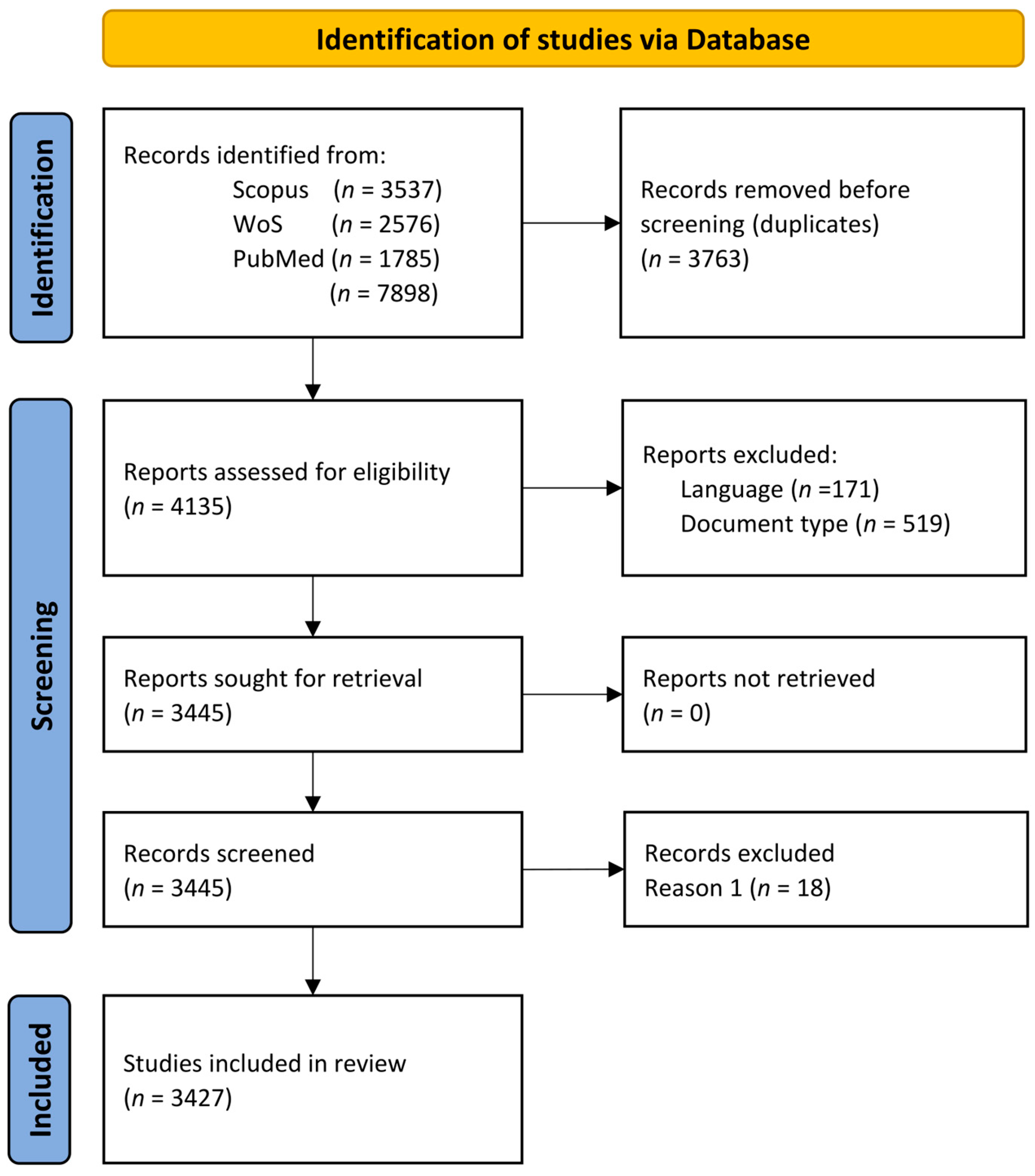
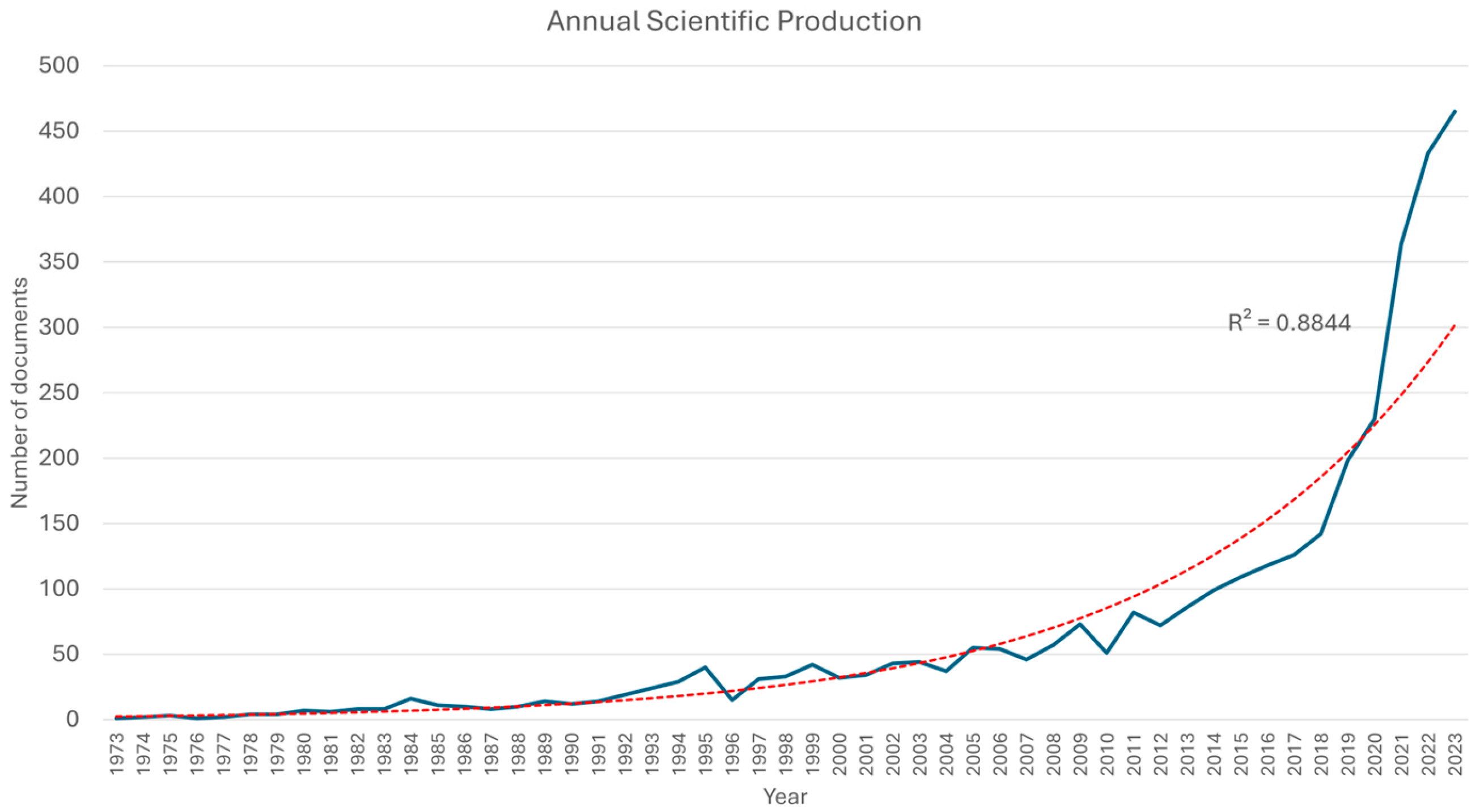

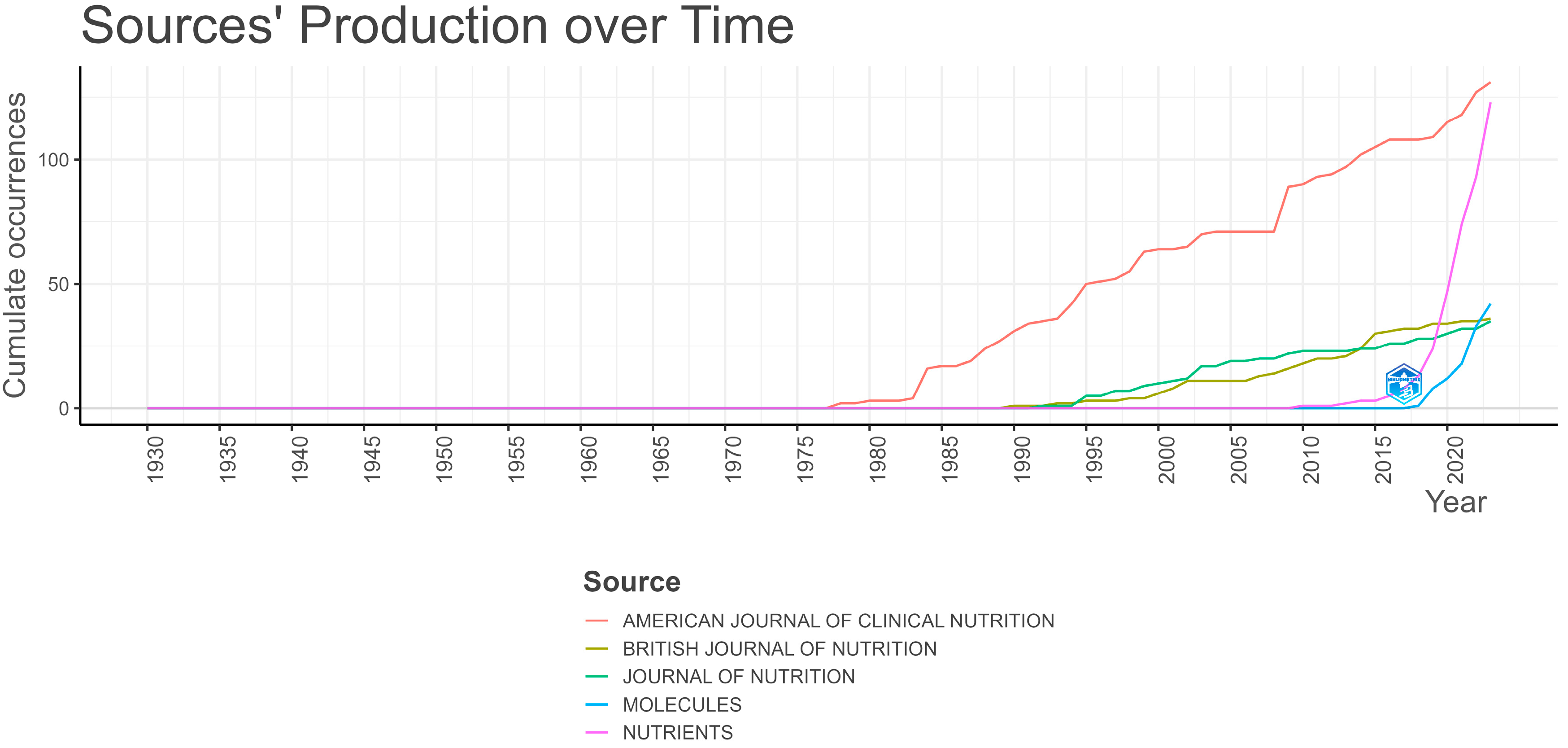
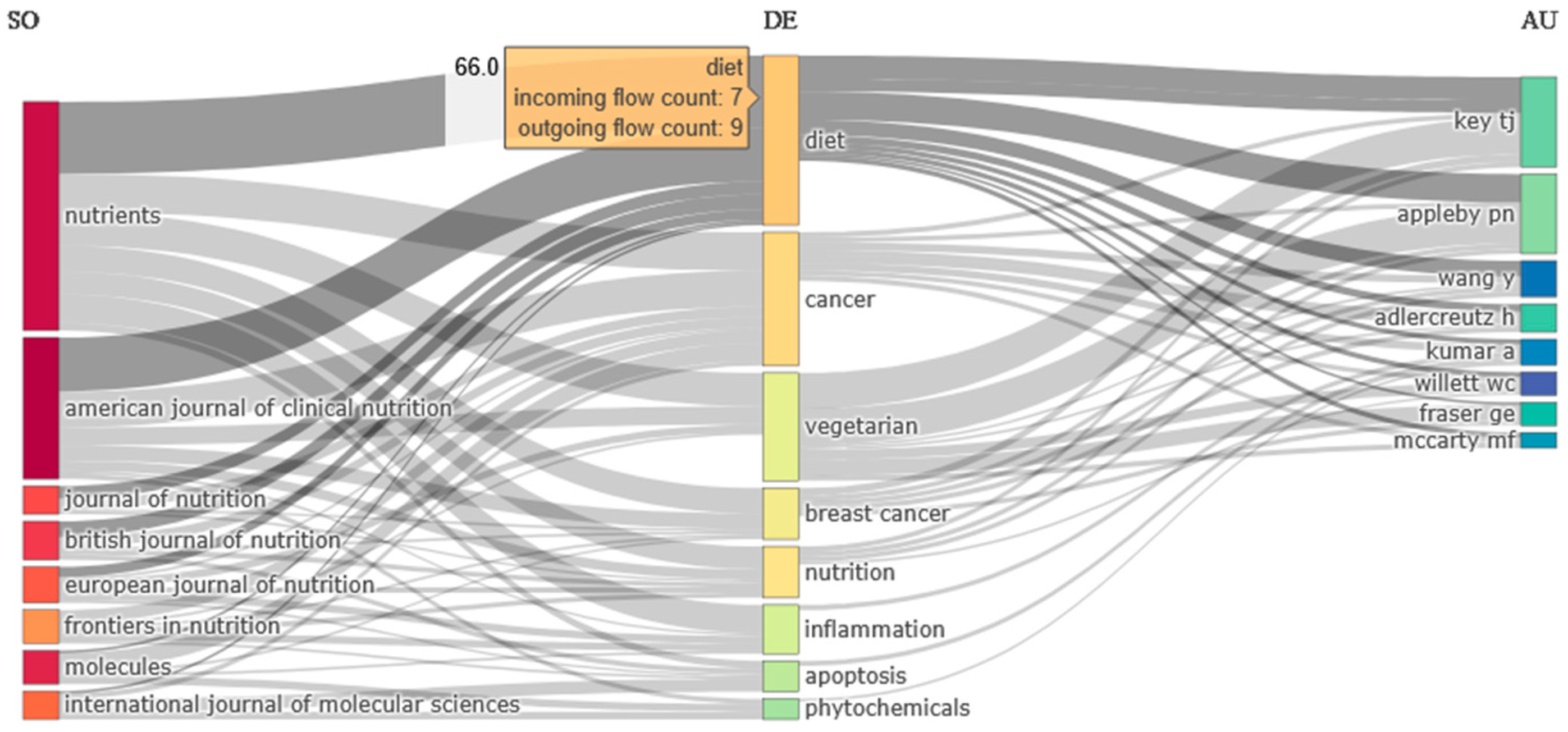
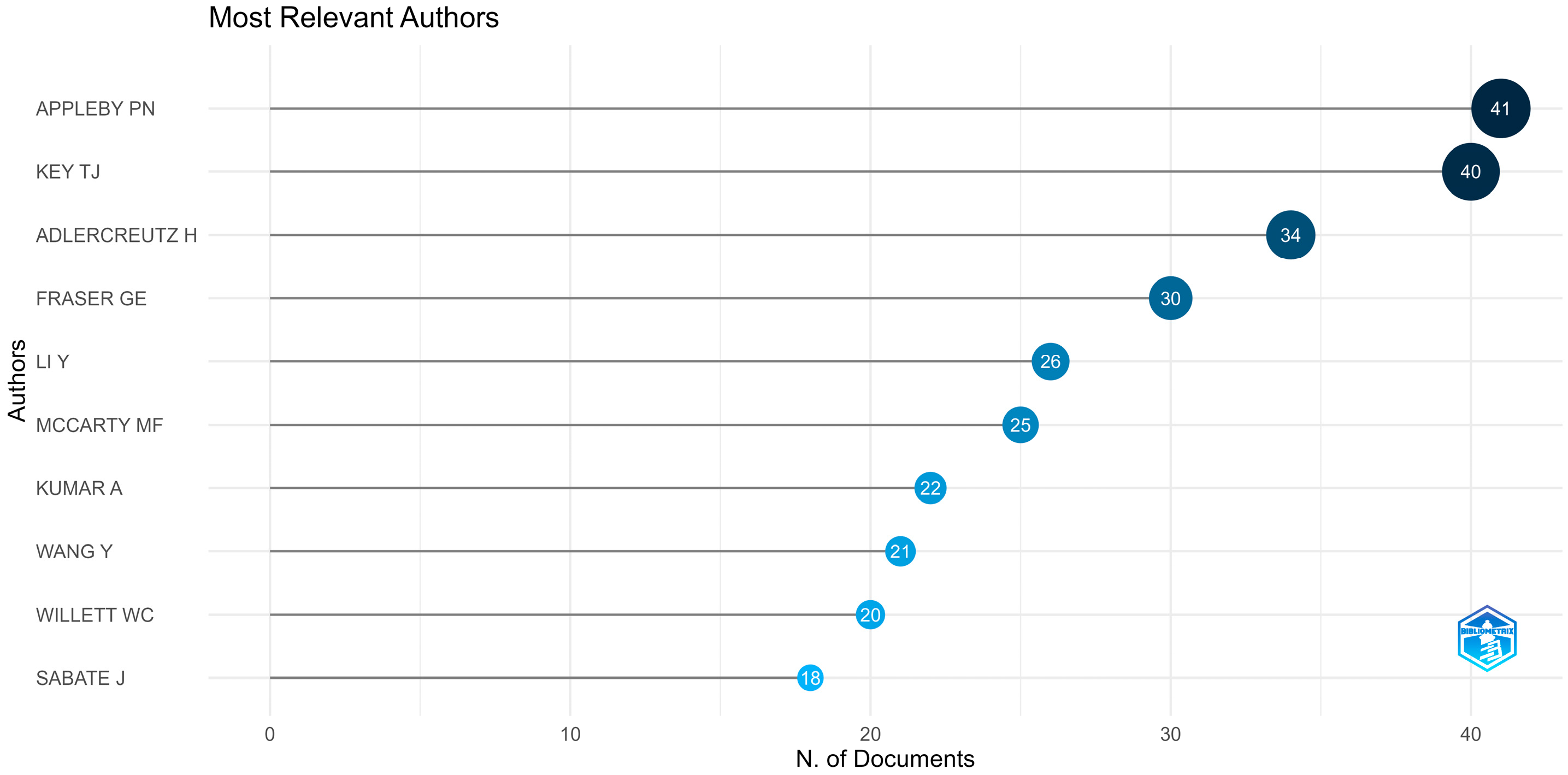

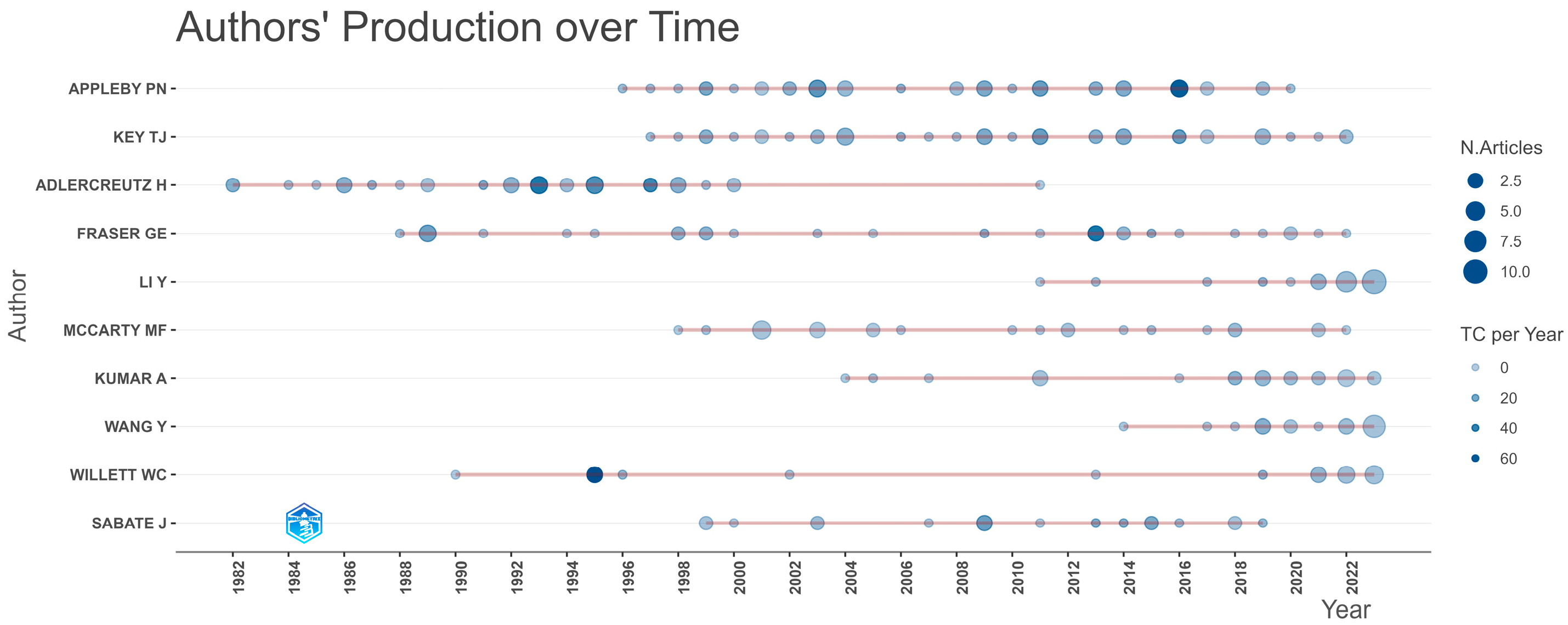


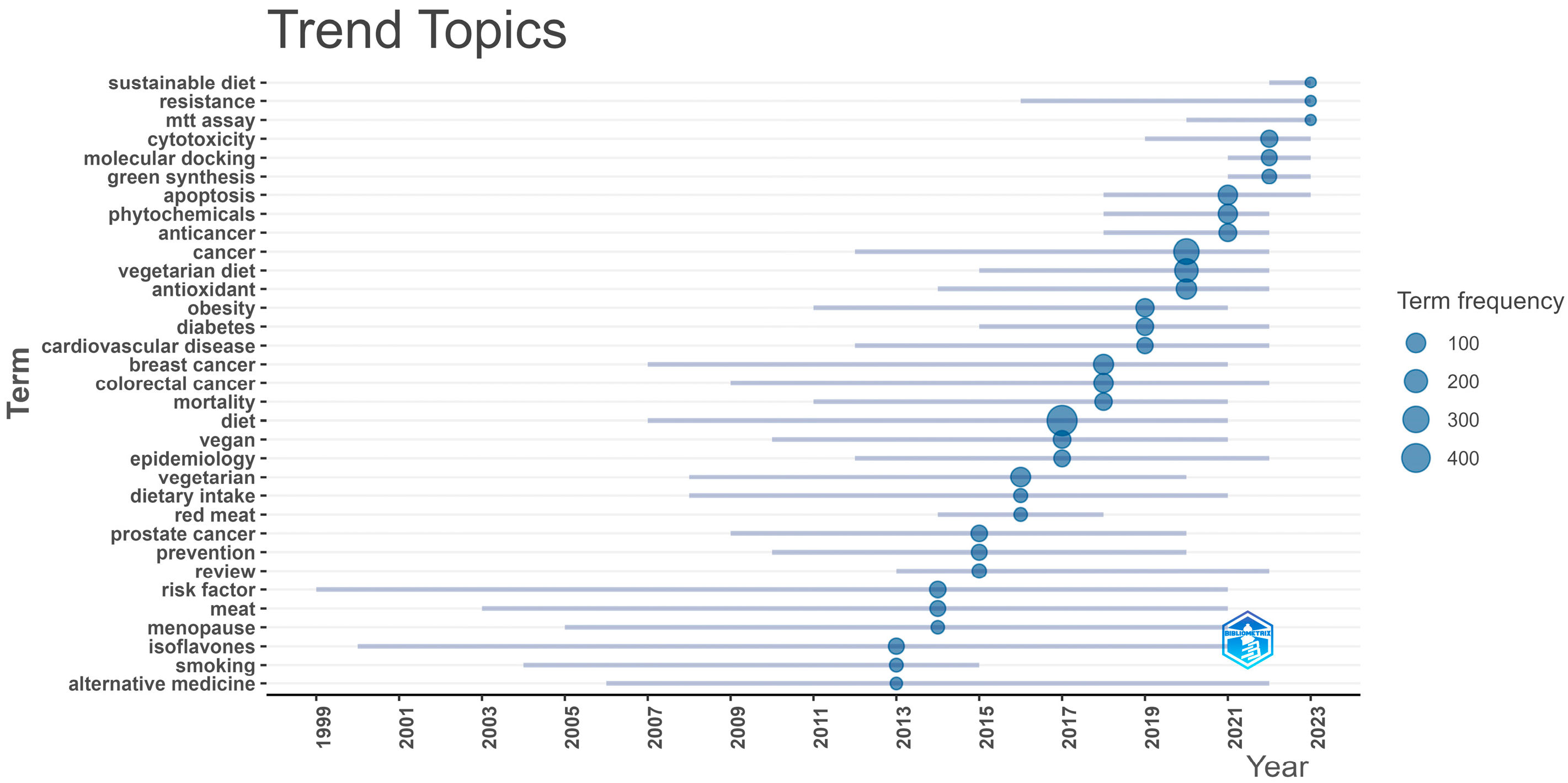

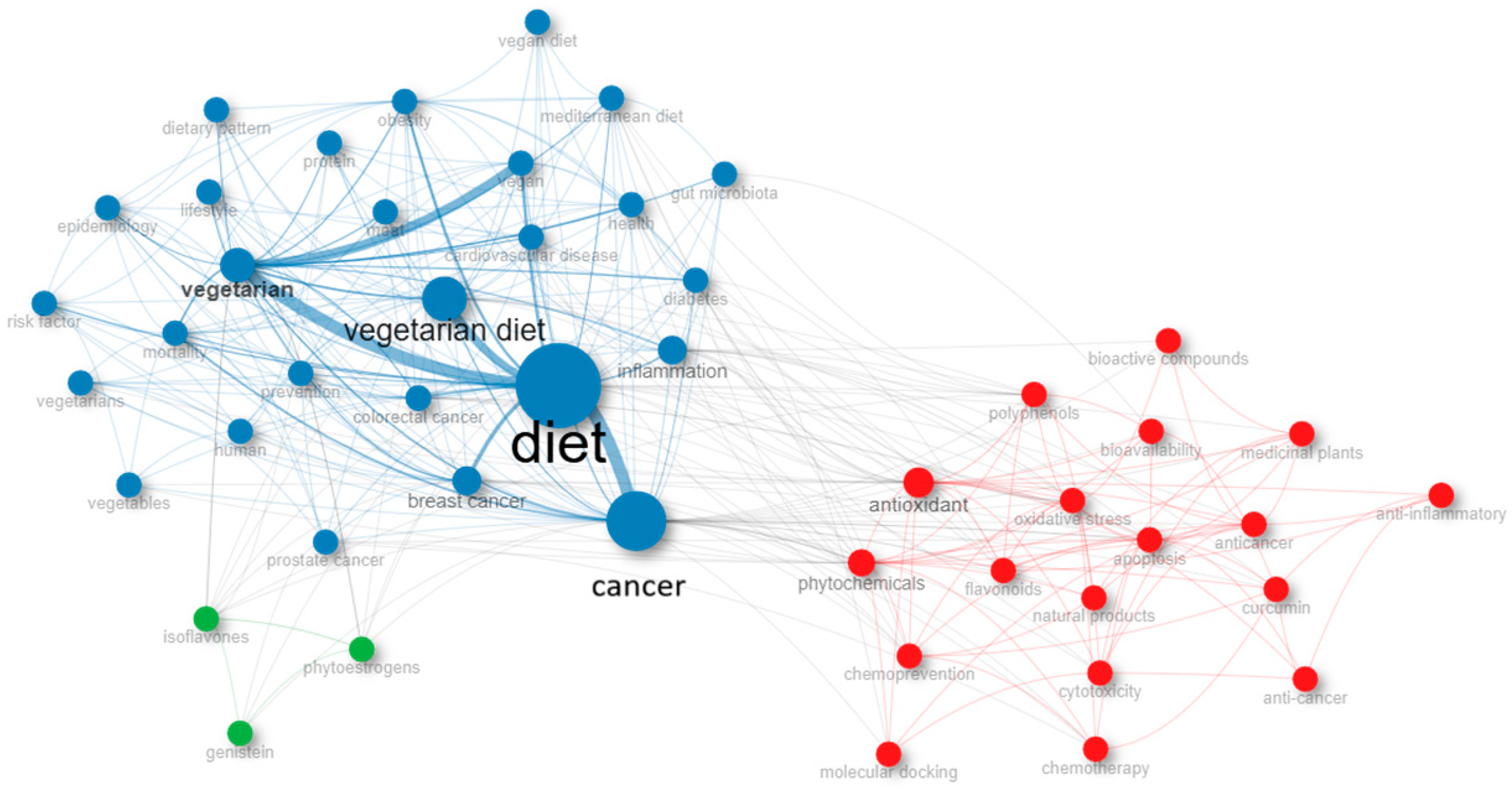
| Topic | Search Terms | Keyword | Databases Final Search Query | ||
|---|---|---|---|---|---|
| WoS | Scopus | PubMed | |||
| Vegetarian Diet | vegan vegans veganism | vegan* | (((((TS=(tumor*)) OR TS=(neoplas*)) OR TS=(cancer*)) OR TS=(carcin*)) OR TS=(malignan*)) AND (TS=(*vegetarian*) OR TS=(vegan*) OR TS=(plant-based)) | (TITLE-ABS-KEY(cancer*) OR TITLE-ABS-KEY(carcin*) OR TITLE-ABS-KEY(tumor*) OR TITLE-ABS-KEY(malignan*) OR TITLE-ABS-KEY(neoplas*) AND TITLE-ABS-KEY(plant-based) OR TITLE-ABS-KEY(*vegetarian*) OR TITLE-ABS-KEY(vegan*)) | ((cancer*[Title/Abstract]) OR (carcin*[Title/Abstract]) OR (tumor*[Title/Abstract]) OR (malignan*[Title/Abstract]) OR(neoplas*[Title/Abstract])) AND ((vegan*[Title/Abstract]) OR(vegetarian*[Title/Abstract]) OR (plantbased[Title/Abstract])) |
| vegetarian vegetarians lacto-ovovegetarian vegetarianism | vegetarian* (PubMed) *vegetarian* (WoS, Scopus) | ||||
| plant-based plant-based | plant-based | ||||
| Cancer | tumor tumors tumorigenesis tumoral | tumor* | |||
| neoplasia neoplasm neoplasms | neoplas* | ||||
| cancer cancers cancerous cancerization | cancer* | ||||
| carcinoma carcinogenic carcinogens | carcin* | ||||
| malignant malignancy malignancy | malignan* | ||||
| Description | Results |
|---|---|
| MAIN INFORMATION ABOUT DATA | |
| Timespan | 1930–2023 |
| Sources (Journals, Books, etc.) | 1407 |
| Documents | 3427 |
| Annual Growth Rate % | 6.83 |
| Document Average Age | 9.86 |
| Average citations per doc | 39.34 |
| References | 188,267 |
| DOCUMENT CONTENTS | |
| Keywords Plus (ID) | 16,849 |
| Author’s Keywords (DE) | 7645 |
| AUTHORS | |
| Authors | 14,005 |
| Authors of single-authored docs | 243 |
| AUTHORS COLLABORATION | |
| Single-authored docs | 286 |
| Co-Authors per Doc | 5.26 |
| International co-authorships % | 19.84 |
| DOCUMENT TYPES | |
| article | 2364 |
| case reports | 1 |
| reprint | 1 |
| review | 1050 |
| short survey | 10 |
| case reports | 1 |
| Sources | Articles |
|---|---|
| American Journal of Clinical Nutrition | 131 |
| Nutrients | 123 |
| Molecules | 42 |
| British Journal of Nutrition | 36 |
| Journal of Nutrition | 35 |
| European Journal of Nutrition | 29 |
| International Journal of Molecular Sciences | 29 |
| Nutrition And Cancer-an International Journal | 29 |
| Frontiers in Nutrition | 28 |
| PLOS One | 28 |
| Words | Occurrences |
|---|---|
| diet | 474 |
| cancer | 271 |
| vegetarian diet | 205 |
| antioxidant | 120 |
| breast cancer | 112 |
| vegetarian | 111 |
| inflammation | 108 |
| colorectal cancer | 97 |
| apoptosis | 96 |
| phytochemicals | 93 |
| Document | Year | Local Citations |
|---|---|---|
| Davey G.K., 2003, Public Health Nutr [52] | 2003 | 73 |
| Satija A., 2017, J Am Coll Cardiol [53] | 2017 | 67 |
| Fraser G.E., 1999, Am J Clin Nutr [54] | 1999 | 62 |
| Key T.J., 2009, Am J Clin Nutr-A [48] | 2009 | 58 |
| Fraser G.E., 2009, Am J Clin Nutr [55] | 2009 | 50 |
| Orlich M.J., 2013, Jama Intern Med [56] | 2013 | 50 |
| Craig W.J., 2009, Am J Clin Nutr [21] | 2009 | 47 |
| Huang T., 2012, Ann Nutr Metab [20] | 2012 | 47 |
| Goldin B.R., 1982, New Engl J Med [57] | 1982 | 45 |
| Melina V., 2016, J Acad Nutr Diet [58] | 2016 | 41 |
Disclaimer/Publisher’s Note: The statements, opinions and data contained in all publications are solely those of the individual author(s) and contributor(s) and not of MDPI and/or the editor(s). MDPI and/or the editor(s) disclaim responsibility for any injury to people or property resulting from any ideas, methods, instructions or products referred to in the content. |
© 2025 by the authors. Licensee MDPI, Basel, Switzerland. This article is an open access article distributed under the terms and conditions of the Creative Commons Attribution (CC BY) license (https://creativecommons.org/licenses/by/4.0/).
Share and Cite
Chrysafi, M.; Gialeli, M.; Giaginis, C.; Troumbis, A.Y.; Vasios, G.K. Studying the Role of Vegetarianism as a Potential Strategy for Cancer Prevention and Treatment, a Bibliometric Analysis. Epidemiologia 2025, 6, 23. https://doi.org/10.3390/epidemiologia6020023
Chrysafi M, Gialeli M, Giaginis C, Troumbis AY, Vasios GK. Studying the Role of Vegetarianism as a Potential Strategy for Cancer Prevention and Treatment, a Bibliometric Analysis. Epidemiologia. 2025; 6(2):23. https://doi.org/10.3390/epidemiologia6020023
Chicago/Turabian StyleChrysafi, Maria, Maria Gialeli, Constantinos Giaginis, Andreas Y. Troumbis, and Georgios K. Vasios. 2025. "Studying the Role of Vegetarianism as a Potential Strategy for Cancer Prevention and Treatment, a Bibliometric Analysis" Epidemiologia 6, no. 2: 23. https://doi.org/10.3390/epidemiologia6020023
APA StyleChrysafi, M., Gialeli, M., Giaginis, C., Troumbis, A. Y., & Vasios, G. K. (2025). Studying the Role of Vegetarianism as a Potential Strategy for Cancer Prevention and Treatment, a Bibliometric Analysis. Epidemiologia, 6(2), 23. https://doi.org/10.3390/epidemiologia6020023









